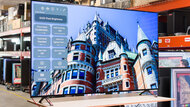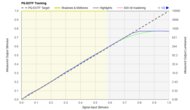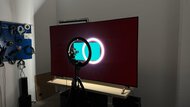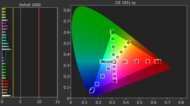Even though 55-inch and 65-inch TV models have become the most popular sizes, smaller TVs are still important to many people. These sizes are ideal for a secondary TV, such as in a student dorm room or a guest room, and if you have the space, even in a kitchen. Although you usually won't get the most advanced features or the very best picture quality, you still want a TV that delivers decent performance and image quality. However, you may want a small top-of-the-line gaming TV to use in place of a monitor, and there are a few solid options for that as well.
By putting dozens of TVs a year through our meticulous testing process, we're able to determine if a TV is bright enough for use in a well-lit room, if it displays vibrant colors, if it has the contrast needed to look good in a dark room, and whether or not it has good gaming performance and smart features. Different people have varying needs and budgets, so our list offers options for almost everyone. Unfortunately, there are very few 24-inch models on the market, and we haven't tested any that are still available, so you won't find the best 24-inch smart TV in this article. However, there are 27-inch monitors that can be used in place of a TV.
Below are our picks for the best small TVs or the best small smart TVs available. See our recommendations for the best 40-42-43 inch TVs, the best 32-inch TVs, and the best multimedia monitors if you need something smaller than 32 inches, or vote on which TVs you want us to buy and test. To learn more about the models released in 2025, check out our 2025 TV lineup page.
Quick Look






We buy and test dozens of TVs yearly, taking an objective, data-driven approach to deliver results you can trust. Our testing process is complex, with hundreds of individual tests that take over a week to complete. Most of our tests are done with specially designed test patterns that mimic real content, but we also use the same sources you have at home to ensure our results match the real-world experience. We use two main tools for our testing: a Colorimetry Research CR-100 colorimeter and a CR-250 spectroradiometer.
-
Best Small TV
 Mixed Usage8.6Home Theater8.8Bright Room7.7Sports8.2Gaming8.8Brightness8.3Black Level10Color8.3Processing (In Development)8.7Game Mode Responsiveness9.3Resolution4kNative Refresh Rate144HzScreen FinishGlossyTypeOLEDSub-TypeWOLEDSee all our test resultsDolby VisionYes
Mixed Usage8.6Home Theater8.8Bright Room7.7Sports8.2Gaming8.8Brightness8.3Black Level10Color8.3Processing (In Development)8.7Game Mode Responsiveness9.3Resolution4kNative Refresh Rate144HzScreen FinishGlossyTypeOLEDSub-TypeWOLEDSee all our test resultsDolby VisionYesLG's C Series of OLEDs have been some of the best small TVs you can buy for the past several years, and the LG C5 OLED is no different, as nothing else comes close to it in this size. It's a fantastic option with incredible picture quality, and it's available in a wide range of sizes, including 42- and 48-inch models that are great for an office or small bedroom. Although the 42- and 48-inch sizes aren't as bright as the larger sizes of the TV, they're still bright enough to fight glare in a room with a few overhead lights on and provide an impactful HDR experience. You also get deep, inky blacks due to its perfect black levels, so the TV looks amazing in a dark room. Additionally, it displays a wide range of colors, so content looks vibrant and lifelike.
The TV even has great image processing, and it supports Dolby Vision, so whether you're watching old DVDs or high-quality 4k streams, you'll be pleased with the image it provides. Its nearly instantaneous response time makes it great for gaming, resulting in crystal-clear motion. It supports HDMI 2.1 bandwidth on all four of its HDMI ports, allowing for 4k @ 144Hz gaming with VRR, meaning you can take full advantage of the PS5/PS5 Pro, Xbox Series X|S, Switch 2, or a PC with a high-end GPU. It runs LG's webOS, which is loaded with apps, so you don't need to pair the TV with an external streaming device.
-
Best Bright Room Small TV
 Mixed Usage8.2Home Theater8.1Bright Room8.7Sports8.5Gaming7.8Brightness9.0Black Level8.3Color7.7Processing (In Development)7.7Game Mode Responsiveness7.8Resolution4kNative Refresh Rate165HzScreen FinishMatteTypeLEDSub-TypeVASee all our test resultsDolby VisionNo
Mixed Usage8.2Home Theater8.1Bright Room8.7Sports8.5Gaming7.8Brightness9.0Black Level8.3Color7.7Processing (In Development)7.7Game Mode Responsiveness7.8Resolution4kNative Refresh Rate165HzScreen FinishMatteTypeLEDSub-TypeVASee all our test resultsDolby VisionNoIf you mostly watch content in a bright room, an LED TV like the Samsung QN90F is better than the LG C5 OLED. The Samsung is an impressive TV with amazing picture quality, and it has incredible peak brightness and stellar reflection handling due to its matte coating, making it easy to see in very bright rooms. You don't get the same inky blacks as you do on the LG C5, but you still get impressive black levels thanks to its Mini LED local dimming feature, although there's some haloing around bright highlights in dark scenes. The TV's upscaling is almost on par with the C5, but its low-quality content smoothing is worse, so low-quality content has visible artifacts present. Fortunately, the TV displays vibrant and lifelike colors that are sure to impress.
It supports 4k @ 165Hz on all four of its HDMI 2.1 bandwidth ports, has low input lag, and supports VRR. These features make it a great choice for those who need a gaming TV to pair with their modern console or a gaming PC. However, its slower pixel transitions mean fast motion is a bit blurry. Unfortunately, the TV's viewing angle is only average, so you must sit directly in front of the screen to achieve the best picture quality. The TV utilizes Samsung's Tizen OS, making it easy to find content to watch. It's available in 43- and 50-inch models.
-
Best Mid-Range Small TV
 Mixed Usage8.2Home Theater8.4Bright Room6.7Sports7.1Gaming8.5Brightness7.0Black Level10Color8.3Processing (In Development)8.3Game Mode Responsiveness9.0Resolution4kNative Refresh Rate120HzScreen FinishGlossyTypeOLEDSub-TypeWOLEDSee all our test resultsDolby VisionYes
Mixed Usage8.2Home Theater8.4Bright Room6.7Sports7.1Gaming8.5Brightness7.0Black Level10Color8.3Processing (In Development)8.3Game Mode Responsiveness9.0Resolution4kNative Refresh Rate120HzScreen FinishGlossyTypeOLEDSub-TypeWOLEDSee all our test resultsDolby VisionYesIf you really like what the LG C5 OLED offers but find it too expensive, consider the LG B5 OLED. The 48-inch model is the smallest size available, but if you can fit it into your room and budget, it's hard to beat. You get the same inky blacks and similarly vibrant colors as on the C5, and it comes with almost all the same features. It's not nearly as bright as the C5 in HDR, but it has just good enough HDR brightness for an impactful HDR experience. Unfortunately, it's significantly dimmer in SDR than the C5, so it's best suited for dark or dimly lit rooms.
It has very similar image processing capabilities, so low-resolution and low-quality content looks almost as good. It even has the same support for Dolby Vision. You won't find 144Hz support on the TV like you do on the C5, but you still get four HDMI 2.1 bandwidth ports for up to 4k @ 120Hz gaming with VRR. You also still get exceptionally low input lag and a nearly instantaneous response time for crystal-clear motion. Like the C5, it runs webOS, which gives you access to every common streaming service.
-
Best Very Small TV
 Mixed Usage5.8Home Theater5.8Bright Room6.4Sports6.3Gaming5.6Brightness5.7Black Level5.0Color6.2Processing (In Development)6.2Game Mode Responsiveness5.6Resolution4kNative Refresh Rate60HzScreen FinishGlossyTypeLEDSub-TypeVASee all our test resultsDolby VisionNo
Mixed Usage5.8Home Theater5.8Bright Room6.4Sports6.3Gaming5.6Brightness5.7Black Level5.0Color6.2Processing (In Development)6.2Game Mode Responsiveness5.6Resolution4kNative Refresh Rate60HzScreen FinishGlossyTypeLEDSub-TypeVASee all our test resultsDolby VisionNoIf you're looking for something smaller than 42 inches, the best very small TV we've tested is the Samsung Q60D QLED. It's available in a wide range of sizes, down to a very small 32-inch model. Although it isn't nearly as good as the LG C5 OLED, the LG B5 OLED, or the Samsung QN90F, it's one of the few TVs you can buy in a very small size without sacrificing performance or reducing the native resolution. It delivers decent picture quality with an okay contrast ratio, vibrant colors, and alright peak brightness in SDR. Unfortunately, it has poor reflection handling, so even though it's okay for a moderately lit room, reflections are very visible in bright rooms.
Sadly, it lacks advanced gaming features like VRR technology to reduce tearing, although that is to be expected for a cheaper model. Despite its support for HDR, it lacks a local dimming feature and cannot achieve sufficient brightness for HDR content to truly stand out. The TV does have good upscaling capabilities, but unfortunately, its low-quality content smoothing is poor. It doesn't have the best image quality, but it's one of the only TVs on the market available in a very small 32-inch size, and you don't have to pair it with an external streaming device since it's a smart TV.
-
Best Cheap Small TV
 Mixed Usage6.0Home Theater5.8Bright Room6.3Sports6.0Gaming6.2Brightness5.6Black Level4.9Color6.8Processing (In Development)6.3Game Mode Responsiveness6.7Resolution4kNative Refresh Rate60HzScreen FinishGlossyTypeLEDSub-TypeVASee all our test resultsDolby VisionYes
Mixed Usage6.0Home Theater5.8Bright Room6.3Sports6.0Gaming6.2Brightness5.6Black Level4.9Color6.8Processing (In Development)6.3Game Mode Responsiveness6.7Resolution4kNative Refresh Rate60HzScreen FinishGlossyTypeLEDSub-TypeVASee all our test resultsDolby VisionYesIf your budget is tight and you just want a basic, small TV with just okay image quality, consider the Hisense QD6QF. It's available in a 43-inch and 50-inch model, so you have a couple of options on the smaller end. It doesn't have local dimming, so blacks appear gray during most scenes. It's bright enough to handle some glare in a moderately lit room, but reflections are visible on the screen in well-lit environments. Highlights in HDR movies, shows, and games don't stand out as they should due to its limited brightness, and the TV struggles to take advantage of the wide color range used in HDR content, leading to an underwhelming HDR experience.
The TV performs poorly in removing artifacts from low-quality content, but it excels at upscaling. It doesn't have many gaming features, but you can still play in 4k @ 60Hz with VRR. Pixel response times are on the slower side, resulting in visible motion blur, but this is acceptable for casual gaming. It runs the Fire TV OS, which has a big selection of streaming apps, so pairing it with an external streaming device isn't necessary. You also get Dolby Vision and HDR10+, so it has good compatibility. The TV isn't anything special at all, but it outperforms other similar models, so it's a solid, cheap option.
Notable Mentions
-
Samsung QN42S90FAEXZA:
The 42-inch Samsung S90F OLED is an alternative to the LG C5 OLED and has most of the same features. Unfortunately, the 42-inch model uses a WOLED panel instead of the QD-OLED panel found on the larger sizes, so it doesn't have the increased color vibrancy. Therefore, the C5 is better since it supports Dolby Vision, is brighter, and has better image processing.
See our review -
LG 42LX3QPAU:
The LG OLED Flex is a 42-inch TV with a screen that can be curved. It's very good and performs similarly to the LG B5 OLED. However, it's expensive and not a good value overall. Unless you need a bendable screen, the B5 is the better option.
See our review
Recent Updates
Nov 17, 2025:
Replaced the TCL Q651G with the Hisense QD6QF in the 'Best Cheap' category. We also removed the Roku Select Series from the Notable Mentions.
Aug 28, 2025:
Replaced the LG C4 OLED with the LG C5 OLED, the Samsung QN90D/QN90DD QLED with the Samsung QN90F, the LG B4 OLED with the LG B5 OLED, and the Hisense A7N with the TCL Q651G. We also tweaked the Notable Mentions section for accuracy.
Apr 17, 2025:
Removed the Sony X85K from the Notable Mentions due to lack of availability, and refreshed some text throughout for accuracy.
Dec 10, 2024:
Refreshed the text in the introduction for clarity and accuracy.
Sep 17, 2024: We replaced the LG C3 OLED, the Samsung QN90C/QN90CD QLED, and the Samsung Q60C QLED with their 2024 successors. We also replaced the Sony X85K with the LG B4 OLED in the 'Best Mid-Range Small TV' category and updated the Notable Mentions.
All Reviews
Our recommendations above are what we think are currently the best small television or the best small smart TV to buy for most people in each price range. We factor in the price (a cheaper TV wins over a pricier one if the difference isn't worth it), feedback from our visitors, and availability (no TVs that are difficult to find or almost out of stock everywhere).
If you would like to do the work of choosing yourself, here is the list of all our reviews of TVs that are available in 43-inch sizes or smaller. Be careful not to get too caught up in the details. While no TV is perfect, most TVs are great enough to please almost everyone, and the differences are often not noticeable unless you really look for them. Also, keep in mind that our scores aren't comparable across different test benches, so most of the older TVs in the list below score higher than they would today.















